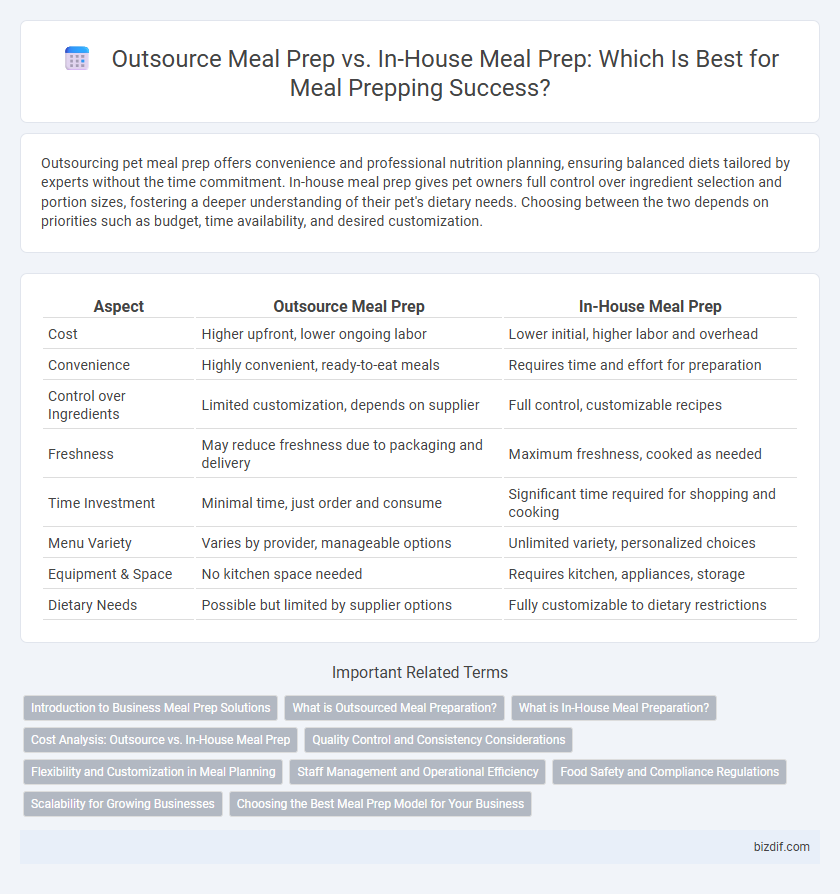Outsourcing pet meal prep offers convenience and professional nutrition planning, ensuring balanced diets tailored by experts without the time commitment. In-house meal prep gives pet owners full control over ingredient selection and portion sizes, fostering a deeper understanding of their pet's dietary needs. Choosing between the two depends on priorities such as budget, time availability, and desired customization.
Table of Comparison
| Aspect | Outsource Meal Prep | In-House Meal Prep |
|---|---|---|
| Cost | Higher upfront, lower ongoing labor | Lower initial, higher labor and overhead |
| Convenience | Highly convenient, ready-to-eat meals | Requires time and effort for preparation |
| Control over Ingredients | Limited customization, depends on supplier | Full control, customizable recipes |
| Freshness | May reduce freshness due to packaging and delivery | Maximum freshness, cooked as needed |
| Time Investment | Minimal time, just order and consume | Significant time required for shopping and cooking |
| Menu Variety | Varies by provider, manageable options | Unlimited variety, personalized choices |
| Equipment & Space | No kitchen space needed | Requires kitchen, appliances, storage |
| Dietary Needs | Possible but limited by supplier options | Fully customizable to dietary restrictions |
Introduction to Business Meal Prep Solutions
Business meal prep solutions offer two primary approaches: outsourcing meal prep to specialized providers or managing it in-house. Outsourcing meal prep reduces labor costs, ensures consistent quality, and allows access to diverse menu options tailored for dietary restrictions, enhancing employee satisfaction. In-house meal prep grants full control over ingredient sourcing, customization, and food safety protocols, which is ideal for companies prioritizing brand-specific nutrition standards and cost management.
What is Outsourced Meal Preparation?
Outsourced meal preparation involves hiring external companies or services to plan, cook, and package meals rather than managing these tasks internally. This approach leverages specialized culinary expertise and commercial kitchen facilities to enhance efficiency and consistency while reducing the need for in-house labor and equipment. Businesses or individuals benefit from scaled meal options, cost control, and time savings by entrusting meal prep to third-party providers.
What is In-House Meal Preparation?
In-house meal preparation involves cooking and assembling meals within the business's own kitchen facilities using internal staff and resources. This method allows for greater control over ingredient quality, customization, and compliance with specific dietary requirements. It often requires significant investment in kitchen equipment, skilled labor, and time management to ensure efficiency and consistency.
Cost Analysis: Outsource vs. In-House Meal Prep
Outsourcing meal prep typically reduces labor and overhead costs by leveraging specialized service providers with bulk purchasing power and streamlined operations. In-house meal prep incurs higher expenses due to staffing, ingredient sourcing, kitchen maintenance, and compliance with food safety regulations. An accurate cost analysis must include direct costs, indirect operational expenses, and potential savings from scalability and waste reduction.
Quality Control and Consistency Considerations
Outsourcing meal prep allows access to specialized kitchens with standardized processes, ensuring consistent quality through professional oversight and certified food safety protocols. In-house meal prep provides greater direct control over ingredient selection and preparation techniques, enabling tailored quality adjustments but requires rigorous training and monitoring to maintain consistency. Balancing these approaches involves weighing resource availability and expertise against desired quality control levels and consistency in meal output.
Flexibility and Customization in Meal Planning
Outsourcing meal prep offers greater flexibility by allowing access to diverse menu options and professional dietary customization tailored to individual preferences or nutritional needs. In-house meal prep provides full control over ingredient selection and portion sizes, enabling highly personalized meal plans that accommodate specific flavor profiles and dietary restrictions. Balancing flexibility and customization depends on the priority between convenience and hands-on meal planning, as outsourcing streamlines preparation while in-house methods enhance precise dietary management.
Staff Management and Operational Efficiency
Outsourcing meal prep reduces the burden on in-house staff, allowing businesses to streamline labor costs and focus on core operations. In-house meal prep demands intensive staff management, including training, scheduling, and quality control, which can impact operational efficiency. Leveraging third-party providers can optimize workflow and ensure consistent meal quality, improving overall productivity.
Food Safety and Compliance Regulations
Outsourcing meal prep to certified providers ensures strict adherence to food safety standards and compliance with local health regulations, minimizing the risk of contamination and liability. In-house meal prep requires rigorous staff training, regular audits, and maintaining compliance with HACCP and FDA guidelines to prevent foodborne illnesses. Maintaining proper documentation and sanitation protocols is critical in both approaches to meet inspection requirements and protect consumer health.
Scalability for Growing Businesses
Outsourcing meal prep offers scalability for growing businesses by leveraging established kitchens, experienced staff, and bulk purchasing power, allowing rapid expansion without the need for significant capital investment. In-house meal prep provides greater control over menu customization and ingredient quality but requires substantial hiring, training, and equipment investment, which can limit scalability. Businesses aiming for quick market reach and cost efficiency often prefer outsourcing, while those prioritizing brand consistency and unique offerings lean towards in-house solutions.
Choosing the Best Meal Prep Model for Your Business
Outsourcing meal prep offers scalability, expert culinary skills, and reduced operational costs, making it ideal for businesses aiming to streamline production and focus on core activities. In-house meal prep provides greater control over ingredient quality, customization, and brand consistency, essential for businesses prioritizing unique menus and high culinary standards. Evaluating factors such as budget, volume, kitchen capacity, and desired brand experience helps determine the optimal meal prep model that aligns with business goals.
Outsource Meal Prep vs In-House Meal Prep Infographic

 bizdif.com
bizdif.com